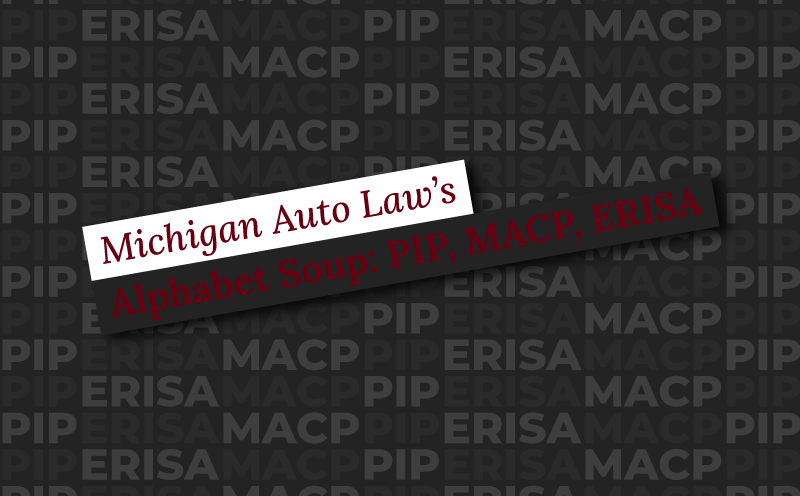Auto Law’s Alphabet Soup: PIP, MACP, and ERISA Health Plans

One of the first steps in a motor vehicle case is the priority analysis, i.e., determining which no-fault insurer is responsible for the victim’s PIP benefits. Before 2019, the priority analysis was like going through driver’s training – a tedious yet critical endeavor that, when successfully completed, led to the open road of uncapped no-fault PIP benefits. Yet the no-fault legislation known as Public Acts 21/22 changed that dynamic by altering the priority rules and imposing monetary caps on PIP benefits for certain victims.
The rules changed most drastically for uninsured occupants and uninsured non-occupants. These are the passengers, pedestrians, and bicyclists injured by motor vehicles who are not named insureds (or domiciled with an insured relative) under a no-fault policy. Under MCL 500.3114(4) and MCL 500.3115, these victims are now required to seek their PIP benefits through the Michigan Assigned Claims Plan (MACP). And when they do, their lifetime allowable expenses are capped at $250,000. See MCL 500.3172(7)(a).
Like all auto accident victims, MACP claimants must undergo a coordination-of-benefits analysis, i.e., determining whether the no-fault insurer or the victim’s health insurance has primary responsibility for medical expenses. Yet because MACP claimants do not have access to an underlying no-fault policy, their coordination-of-benefits analysis is left to statute. Under MCL 500.3172(5), MACP claimants are presumptively coordinated, i.e., they are required to look first to health insurance for payment of accident-related medical expenses. The statute has two exceptions for claimants whose only form of health insurance is Medicaid or Medicare. For these individuals, the assigned no-fault insurer has primary responsibility. Id.
What about MACP claimants who have health insurance through self-funded ERISA health plans? What is the primary source of payment for their medical expenses? These were the questions recently addressed by the Michigan Court of Appeals in George v Allstate Ins Co, 329 Mich App 448 (2019). In George, the plaintiff sought PIP benefits through the MACP. But the plaintiff was also covered under a self-funded ERISA health plan that had an unambiguous coordination-of-benefit clause, making the ERISA plan secondary to auto insurance. In other words, both the health plan and the no-fault insurer pointed the finger of responsibility at each other.
To resolve this conflict, the George court looked to the Michigan Supreme Court’s decision in Auto Club Ins Ass’n v Frederick & Herrud, Inc, 443 Mich 358 (1993). The Auto Club court held that when a self-funded ERISA plan has an unambiguous coordination-of-benefits clause, federal preemption requires the ERISA plan to be secondary to the no-fault insurer.
Although Auto Club involved coordination analysis under MCL 500.3109a, the George court held that its analysis applied to MACP claimants. As such, the MACP-assigned insurer was deemed primary.
This holding has far-reaching implications for auto liability cases. Why? Because under Public Acts 21/22, tortfeasors are now liable for a victim’s medical expenses above the PIP cap. See MCL 500.3135(3)(c). Thus, whenever a MACP-assigned insurer is forced to pay primary, the $250,000 PIP cap is exhausted quicker, and the tortfeasor’s liability expands.
– Article authored by Grand Rapids personal injury lawyer, Thomas G. Sinas


